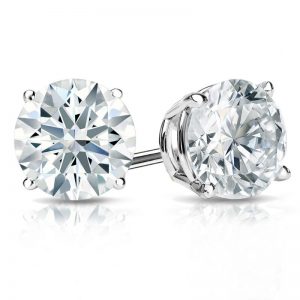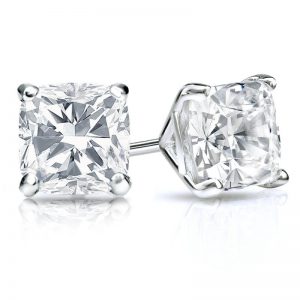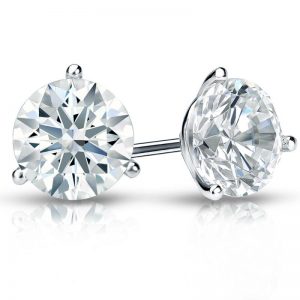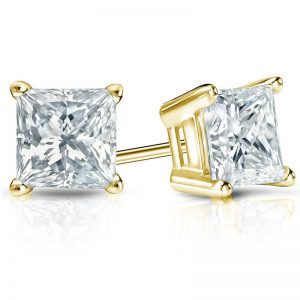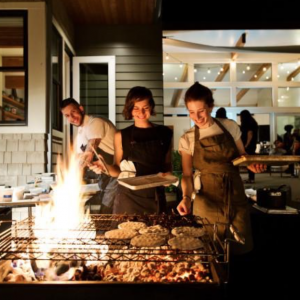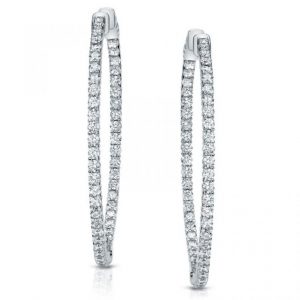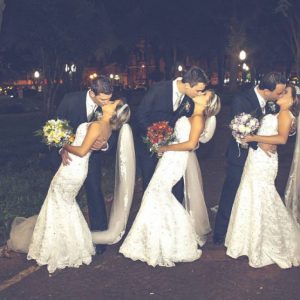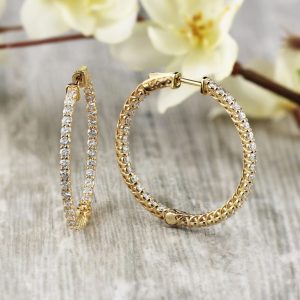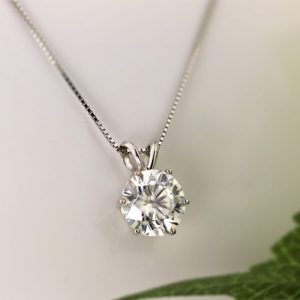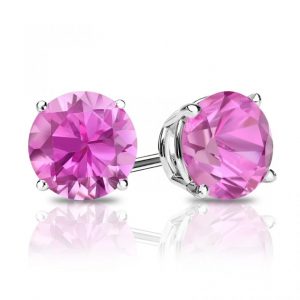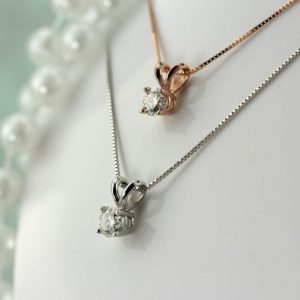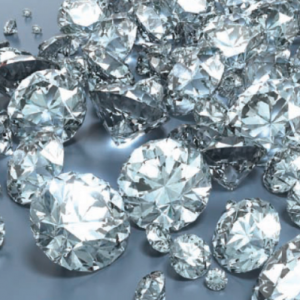Diamond studs are, without a doubt, one of the most universally desired accessories. Their combination of classic stud settings with timeless diamonds has made them a true classic. This has made diamond studs a must have for many people. However, due to the higher cost of diamond jewelry, they are also often viewed as an investment and luxury item. When it comes to buying a piece of jewelry that you will want to wear long term, it’s important to educate yourself about what you’re buying so you’ll feel confident in your choice.
What should you consider when shopping for diamond studs? Well, it’s important to note that they are a versatile and customizable piece. In their most basic form, they consist of a diamond placed into a metal stud setting. However, there many different variations and elements that go into crafting a pair of diamond stud earrings. You can customize each of them to get exactly what you want. This endless customization may sound daunting to some but, never fear— we’ve put together a guide to help you know exactly what you’re buying so you can choose what’s right for you
What should you consider when choosing the diamonds for your diamond studs? There are four major criteria to know about any diamond you buy. These are commonly referred to as The Four C’s and consist of the diamond carat, cut, color, and clarity.
First, let’s talk about diamond carat. Carat is simple to understand— it is the weight of the diamond, which tells you the size of the diamond. You’ll want to consider the carat weight and size of your diamond studs when thinking about what would look best to frame the face.
Next, is the diamond cut. The cut of a diamond is a description of how well it has been shaped. Diamonds are cut in different ways to improve their brilliance and beauty. There are different styles of cuts, like round brilliant and fancy, that reflect the light that enters a diamond in different ways. But these are merely styles and not a reflection of quality.
Ultimately, how well a diamond was cut is what is important and it is what is measured when you see a cut’s “grade.” The official GIA grades for cuts are Excellent, Very Good, Good, Fair, and Poor. Having a well-cut diamond is extremely important as a better cut can improve a diamond’s sparkle and a bad one will cause the diamond to be less radiant.
Diamond color is different from colored diamonds. Colored diamonds are diamonds that have a variety of naturally occurring hues, like yellow, pink, or blue. But the color of a diamond is a way of grade the whiteness of a white diamond. They are graded on a scale from D to Z, with D being the most colorless and Z being the most “yellow” grade of white diamond. When considering diamond color, you’ll want to think about how important it is to you that a diamond be colorless.
The final of The Four Cs is clarity. Clarity measures the amount of inclusions (imperfections inside the diamond) and blemishes (imperfections outside the diamond) of a diamond. Inclusions and blemishes can make a diamond seem cloudy, make it sparkle less, or cause it to just generally look less beautiful. Clarity is measured using magnifications and diamonds are given one of the following grades: FL (Flawless), IF (Internally Flawless), VVs1 or VVs2 (Very, Very Slightly Included), VS1 or VS2 (Very Slightly Included), SI1 or SI2 (Slightly Included), I1 or I2 or I3 (Included).
So, every diamond you can buy will have a description for each of these things. To summarize: the diamond cut measures the cut quality, carat describes the diamond size and weight, and color and clarity describe the brilliance of the diamond. Think about what’s important to you when weighing which diamonds will work best for you.
First, let’s look at what the shape of a diamond is. The shape of a diamond is exactly what it sounds like: it is the shape a rough diamond has been cut into. The shape of your diamond makes a huge difference in the style of your earring, and it also changes how it will sparkle. If you’re not sure what style is right for you, you can consider that shapes often fall into one of three styles: classic and most used (round, hearts and arrows, princess), cuts with a vintage feel (cushion, asscher, emerald), and more unique cuts (marquise, oval, pear).
Among the most classic and popular shapes are round, hearts and arrows, and princess. Round diamonds are the most popular of all diamond shapes. Round shapes are exceptionally brilliant, allowing for the maximum amount of light to enter the diamond. This cut is what comes to mind for many people when they think of diamond studs.
The hearts and arrows style is similar to the round shape upon first glance, as it has an overall round shape. However, the specific way a diamond and arrow shape is cut creates a distinct magnificence, due to its incredible polish and symmetry. This cut subtly creates heart and arrow shapes in the diamond, creating an incredible shimmer.
The princess style rounds out the most popular shapes. It has distinct look, with its square face. The princess diamond cut is relatively new. It was created in the 1960s and quickly gained popularity due to its brilliance and slightly lower price per carat that round diamonds. Princess shaped diamonds are a great way to get more glamour out of each carat.
The next three shapes we’ll discuss are still classic shapes but have a slightly more vintage feel. The cushion cut diamond (also known the old mine cut) was the most popular cut for many years, until it was edged out by the round cut. The top of this shape of diamond looks a bit like a square with rounded corners. This cut doesn’t return quite as much light as a round diamond but it is more likely to have more fire and many people today are drawn to its vintage look.
The Asscher cut was incredibly popular in the 1920s and has resurged in popularity today among those who love its 1920s feel. This diamond style is easily recognized by its distinct square shape with edged corners. The last “vintage style” shape is the emerald cut.
The emerald cut looks a bit like an elongated asscher but it has a distinctly unique cut. It is step cut rather than brilliant cut like most diamonds. This mean that it doesn’t have quite the sparkle of brilliant diamonds but it looks bigger and can create larger flashes of light.
The last three shapes we’ll talk about are the “unique” looking shapes. These veer away from traditional round or rectangular shapes to create a distinct look. First, we have the marquise cut. This cut has a kind of football shape from above and is created with a brilliant cut for sparkle. It’s a good choice for making a diamond seem larger, due to it having so much of its surface area on its top, and for creating a unique look. The marquise shape also has a rich history— this shape was originally created in the court of King Louis XIV of France and was designed to resemble his mistress’ beautiful and sparkling smile.
The oval shape is another popular one for creating a unique look. It’s a modern, elongated version of the round shape. It feels both classic and a bit off the beaten path. There are many different widths of oval shapes to give you exactly the look you want.
Lastly, we have the pear shape. This shape, also known as a teardrop shape, is elegant and bold. It has become increasingly popular with today’s shopper, as more and more people look for jewelry that sets them apart from the crowd.
Once you’ve decided on your diamonds, you will then pick your setting. There are two major things to consider when choosing a setting: you must choose the design of your setting and your choice of backing. There are two setting designs to choose from: prong and bezel.
Each of these settings have their own advantages. The bezel setting circles the diamond almost completely, generally showing only the top of the diamond. This provides the diamond with greater protection from any wear and tear, as well as greater security from being dislodged. Some people also prefer the modern look of a bezel setting. On the other hand, a prong setting exposes more of the diamond, allowing more of the stone to be seen. This may allow more light into the diamond, allowing it to sparkle more, and it also makes it appear a bit larger. Prongs are a beautiful setting but they do require a bit more upkeep. You’ll want to occasionally get the setting checked to make sure the prongs do not slip out of place, resulting in the potential loss of your stone.
Your Metal
After you’ve chosen the style of setting you want, it’s time to choose your metal. Basically, you’ll want to choose which precious metal you’d like your setting to be made of. The most common fine materials for diamond studs are platinum and various types of gold.
Platinum has the advantage of being extremely durable. It is an incredibly hard metal and is far less likely to scratch or bend than other metals. It looks similar to white gold but is more durable. Now, gold is more versatile than platinum. It comes in yellow gold, white gold, and rose gold. The shade of gold you pick depends on your personal style. When buying gold, you’ll also see a number next to it, most commonly “14k” or “18k.” This is the karat of the metal. Gold karat is a label that tells you what percentage of pure gold is in your metal. Pure gold is too soft for everyday wear so gold is usually mixed with other metals to make it more durable. The higher the karat, the higher the percentage of gold in the metal. 24k would be 100% gold, 18k is 75% gold, and 14k gold is 53.8% gold. So, when choosing your karat, know that a higher karat means that there is more gold in the metal but also know that that means that it would be more easily scratched.
The Perfect Diamond Stud Earring
Now you know what you need to know, in regards to your diamond stud options. All that’s left to do is decide which to choose. Ultimately, you should pick whatever you think you (or whoever you are shopping for) will enjoy the most. Diamond studs are about enhancing your own style and adding more sparkle to your life. Pick studs that speak to you and you will love them for a lifetime.
It’s also important to make sure you purchase your studs from an authorized and reputable retailer, especially if you’re buying your diamonds online. Here at DiamondStuds.com, we sell diamonds that come with a certificate of authenticity, and are also conflict-free. We never compromise on quality and customer satisfaction. Check out our huge array of customizable diamond studs and find the pair you’ll love today. With our custom diamond studs, you can choose your ideal shape, place it into the setting you’d like, choose your precious metal, and then choose your diamond size and quality. We strive to make getting certified, customizable diamond studs as transparent and fun as possible. We hope that this comprehensive guide has made it even easier for you to select your perfect pair of diamond stud earrings.







 1-855-969-7883
1-855-969-7883 info@diamondstuds.com
info@diamondstuds.com


